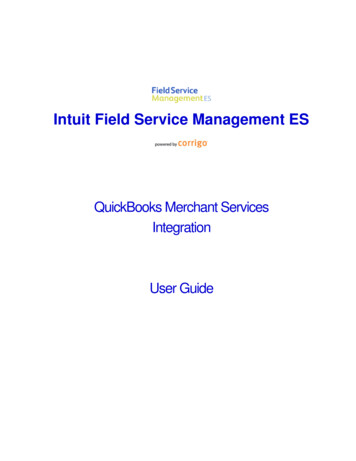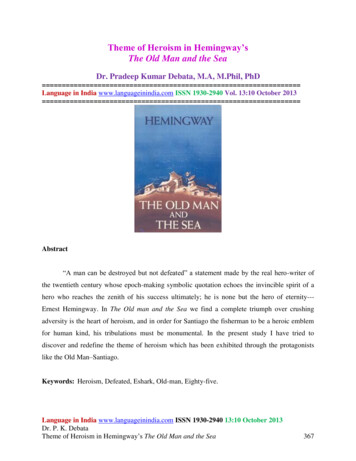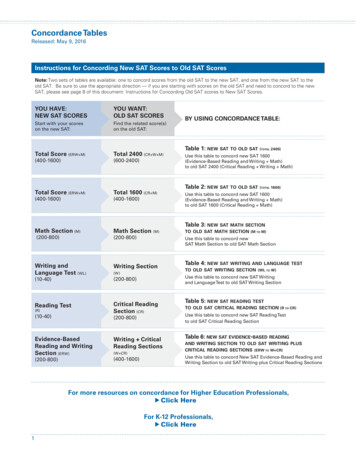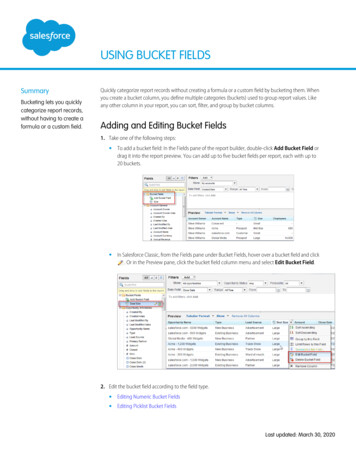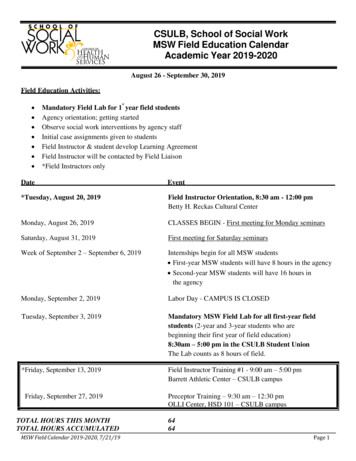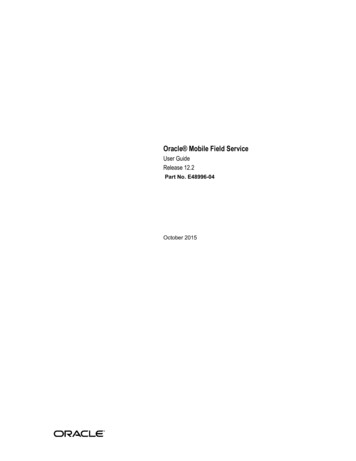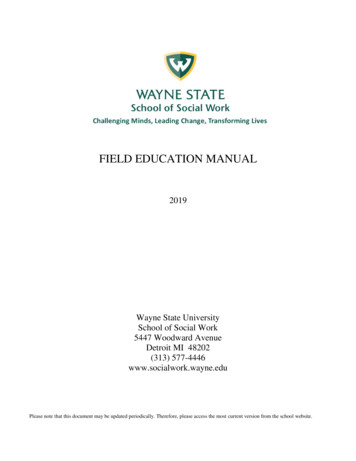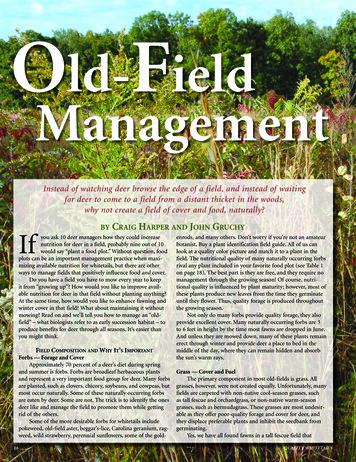
Transcription
Old-FieldManagementInstead of watching deer browse the edge of a field, and instead of waitingfor deer to come to a field from a distant thicket in the woods,why not create a field of cover and food, naturally?Ifby Craig Harper and John Gruchyyou ask 10 deer managers how they could increasenutrition for deer in a field, probably nine out of 10would say “plant a food plot.” Without question, foodplots can be an important management practice when maximizing available nutrition for whitetails, but there are otherways to manage fields that positively influence food and cover.Do you have a field you have to mow every year to keepit from “growing up”? How would you like to improve available nutrition for deer in that field without planting anything?At the same time, how would you like to enhance fawning andwinter cover in that field? What about maintaining it withoutmowing? Read on and we’ll tell you how to manage an “oldfield” – what biologists refer to as early succession habitat – toproduce benefits for deer through all seasons. It’s easier thanyou might think.Field Composition and Why It’s ImportantForbs — Forage and CoverApproximately 70 percent of a deer’s diet during springand summer is forbs. Forbs are broadleaf herbaceous plantsand represent a very important food group for deer. Many forbsare planted, such as clovers, chicory, soybeans, and cowpeas, butmost occur naturally. Some of these naturally occurring forbsare eaten by deer. Some are not. The trick is to identify the onesdeer like and manage the field to promote them while gettingrid of the others.Some of the more desirable forbs for whitetails includepokeweed, old-field aster, beggar’s-lice, Carolina geranium, ragweed, wild strawberry, perennial sunflowers, some of the gold16enrods, and many others. Don’t worry if you’re not an amateurbotanist. Buy a plant identification field guide. All of us canlook at a quality color picture and match it to a plant in thefield. The nutritional quality of many naturally occurring forbsrival any plant included in your favorite food plot (see Table 1on page 18). The best part is they are free, and they require nomanagement through the growing season! Of course, nutritional quality is influenced by plant maturity; however, most ofthese plants produce new leaves from the time they germinateuntil they flower. Thus, quality forage is produced throughoutthe growing season.Not only do many forbs provide quality forage, they alsoprovide excellent cover. Many naturally occurring forbs are 3to 6 feet in height by the time most fawns are dropped in June.And unless they are mowed down, many of these plants remainerect through winter and provide deer a place to bed in themiddle of the day, where they can remain hidden and absorbthe sun’s warm rays.Grass — Cover and FuelThe primary component in most old-fields is grass. Allgrasses, however, were not created equally. Unfortunately, manyfields are carpeted with non-native cool-season grasses, suchas tall fescue and orchardgrass, or non-native warm-seasongrasses, such as bermudagrass. These grasses are most undesirable as they offer poor-quality forage and cover for deer, andthey displace preferable plants and inhibit the seedbank fromgerminating.Yes, we have all found fawns in a tall fescue field thatQUALITY WHITETAILS
Few people recognize the importance of forbs whenmanaging old-fields for deer. Forbs, such as this beggar’s-lice (left), comprise approximately 70 percent ofa whitetail’s diet during spring and summer. Later, thestructure of many forbs, along with native warm-season grasses, provides excellent winter cover (above).wasn’t hayed in June, and we have seen deer eating orchardgrass. We have also seen human beings eating out of trashcansand sleeping on the sidewalk. The point is, what we observe isnot necessarily the way things should be. Sometimes animals,like humans, eat certain things and use certain habitats becausenothing else is available. If the fawns on your property areforced to bed in tall fescue fields and the adult deer are limited to eating orchardgrass, rest assured that is an indicationof overall poor-quality habitat. Without question, you can domuch to improve the quality of cover and available nutritionjust by getting rid of these grasses and allowing the seedbank torespond!Desirable grasses in old-fields include several species ofnative warm-season grasses (NWSG), specifically big and littlebluestem, broomsedge bluestem, indiangrass, switchgrass, andeastern gamagrass. These grasses are preferable to the nonnative grasses mentioned above because NWSG provide betterfawning cover and winter cover. NWSG are not, however, promoted for food. Deer eat very little grass of any kind during thesummer. In winter, while non-native grasses provide virtuallyno cover whatsoever, NWSG can provide deer with outstandingwinter cover, especially if there is a desirable forb componentgrowing with the grasses that helps provide structure.JUNE 2007Cover is not the only benefit of NWSG in an old-field.When it comes time to manage the field, grass cover is essentialto carry prescribed fire. Without grass, it can be quite difficultto burn a field because of a lack of fine fuels near the ground.Without fine fuels to carry the fire, excessive wind is needed toburn a field of forbs, which typically have only a single stemfrom the ground up to 2 feet or more where the dead foliageoccurs. As we’ll cover later, fire is an integral component in oldfield management.Shrubs and Brambles — Don’t Fear Them!Do you look at a field that contains shrubs and bramblesand cringe? If so, you need to put on your rose-colored glasses.These are some of the most important plants in the field!Sumac, blackberry, wild plum, elderberry, crabapples, hawthorn– all of these and others provide an excellent source of foodand cover within old-fields. Unfortunately, the brushy appearance of these species in an old-field often gets them “bushhogged” before they can provide any benefit.To enable an old-field to provide maximum benefit fordeer, it is absolutely critical that you allow forbs, grasses, andshrubs and brambles to develop. A field of pure NWSG mayContinued.17
provide cover, but its overall value fordeer is far less than an old-field withmore diverse vegetation.Field RenovationGet Rid of the CarpetYour first step in enhancing anold-field is to eradicate the non-nativegrasses. We like to call this “removingthe carpet.” Why? Because cool-seasongrasses and bermudagrass form a matover the field that inhibits the seedbankfrom germinating. When this carpet isremoved, seeds in the top few inches ofsoil are able to germinate, and desirableplants can be promoted. This is whereyour forbs come from. We think it isanalogous to removing an ugly shagcarpet in an old house and finding abeautiful hardwood floor underneath.The only way to get rid of the carpet is by spraying the appropriate herbicide. Moldboard plowing will not eradicate problem grasses, such as tall fescue,orchardgrass, bermudagrass and johnsongrass. Within two years, they will beback. Different grasses require differentherbicides and different spraying techniques. Regardless, before spraying, it isTable 1. Percent crude protein (CP) and acid detergent fiber for selected forbs and shrubscollected in June after burning an old-field in April in McMinn County, Tenn.Common nameScientific nameCP*Brood Cover Seed ValueDeerfor BirdsValueFiber** PreferencePokeweedOld-field asterPrickly lettuceBlackberryPartridge peaBeggar’s-liceRagweedSumacGoldenrod3-seeded mercuryJapanese honeysuckleCanadian horseweedSericea lespedezaPassion flowerPhytolacca americanaAster pilosusLactuca serriolaRubus spp.Chamaecrista fasciculataDesmodium spp.Ambrosia artemisiifoliaRhus spp.Solidago spp.Acalypha virginicaLonicera japonicaConyza canadensisLespedeza cuneataPassiflora neMedLowNoneLowLow*Forage samples contained leaves only because that was the part of the plants deer commonly ate.Stems were not included. **Low fiber is desirable because plants are more easily digestible.It is important to note that while deer are selective in what they eat, plants are not necessarilyeaten based on nutritional content. While pokeweed, old-field aster, and prickly lettuce werebrowsed heavily, blackberry, partridge pea, beggar’s-lice, ragweed, goldenrod, and 3-seededmercury were only browsed moderately. Japanese honeysuckle, a highly preferred deer foragein many southern locations, had a low preference value in this study. For other species, such aspassion flower and sericea lespedeza, there was no sign of browsing at all, even though crudeprotein and digestibility ratings were high. Deer density in this area was approximately 25 persquare mile and quality forage was not lacking as there were plenty of soybean fields as wellas warm- and cool-season food plots on the farm. Also shown is the estimated value of theseplants for wild turkeys and bobwhite quail.From the Pagesof Quality WhitetailsThis article first appeared in the June 2007issue of Quality Whitetails, the membershipjournal of the Quality Deer ManagementAssociation (QDMA). For more informationabout QDMA or to become a member, visitwww.QDMA.com or call (800) 209-3337.18QUALITY WHITETAILS
grow with a vengeance. Allow the grasses to grow 6 to 10 inches,then spray with a glyphosate herbicide. Spraying in the fall isrecommended because a better kill is realized versus spraying inthe spring and also because desirable NWSG and forbs are notharmed by fall spraying.To eradicate non-native warm-season grasses, spray in thesummer. Spray bermudagrass with Arsenal in late June, aboutthe time bermudagrass begins to flower. Spray johnsongrasswith a glyphosate herbicide when it reaches about 18 inches inheight. If johnsongrass is growing among desired plants, such asbroomsedge or blackberry, use an imazapic-based herbicide, suchas Plateau, and you will not harm many desirable plants.Continued.The first step in renovating an old-field for deer and other wildlife isto eradicate the non-native grasses, such as tall fescue and orchardgrass (inset). These grasses are extremely low preference forages fordeer and provide no cover during winter. Further, these grasses act asa carpet over the field, smothering the seedbank and inhibiting moredesirable plants from germinating.critical to prepare the field for spraying by burning or haying. Youmust spray actively growing grass, and you don’t want dead leavesand stems to block the herbicide from coming in contact with thetarget plant.To get rid of perennial cool-season grasses, prepare the fieldfor spraying by burning or haying in September (August if youare in the North). After burning, the cool-season grasses willFall is the best time to spray perennial cool-season grasses. Beforespraying, it is essential to prepare the field by haying or burning toencourage fresh grass growth and remove dead plant material thatwill block herbicide contact.Quality Food Plotsyour guide to better deer and better deer huntingThe MOST comprehensive book on food plots EVER PRODUCED!but don’t just take our word for it . . .“Quality Food Plots is well-written, beautifully illustrated, and informative. Anyone who isinterested in growing food plots for deer needs a copy.”– Don Ball, Extension Agronomist/Professor, Auburn University, co-author of Southern Forages: ModernConcepts for Forage Crop Management“You will be impressed with this semi-technical book that will also serve nicely as aclassroom text.” – Southern Regional Extension Forestry Web site, an educational resource for Extensionforestry and wildlife professionals“This book covers all aspects of food plots in a highly readable, hunter-friendly form, withhundreds of photos and graphics. Of particular interest to food plot planters who like to dabblein the smorgasbord of potential plantings are the 37 species profiles.”– Brad Bailey, editor, Georgia Outdoor News magazine Written By Professionals full Color 324 Pages 14 ChaPters ComPrehensive referenCeTo order call (800) 209-3337 or visit www.QDMA.comJUNE 200719
Be Patient!When desirable native plantsPatience is a virtue, andhave not emerged by the secondthis is certainly true whenyear after eradication of non-nativegrasses, planting suggested mixesrenovating old-fields forlike this one is recommended:wildlife. Even if you sprayed2 lbs./acre switchgrassproblem grasses exactly as1 lb./acre big bluestemrecommended, there will usu1 lb./acre indiangrassally be some residual growth1 lb./acre broomsedge bluestemthe following year. This is not2 lbs./acre forbsa problem – just spot sprayas needed. Rome wasn’t builtin day, and your old-field is not going to provide perfect habitatovernight. It will take two to three years to develop.Once you have gotten rid of the carpet, you must wait andsee what the seedbank contains. Often, desirable plants recolonizethe site quickly. But sometimes, one non-native problem is followed by another. For example, it is not uncommon to eradicateone carpet of tall fescue only to find another carpet of bermudagrass or johnsongrass lying underneath. Or, problem forbs suchas sericea lespedeza or thistles might arise. That’s OK – don’t bediscouraged! It just means you have some more spraying to do.With persistence, you will get rid of all the old carpet layers andstimulate the plant community you are looking for. This will nothappen, however, unless you diligently eradicate the invasive nonnative plants that suppress the desirable plants.Do You Need to Plant?We hardly ever recommend anyone plant NWSG and associated forbs until they have waited at least one to two years afterkilling the non-native grass cover. As soon as the non-native coveris killed, there will be plants germinating from the seedbank. Mostof these will be annuals. The perennial plants will increase overthe next two years. Remember, these plants have been smotheredby a carpet for many years, just waiting for a chance to germinate.Often, it takes time to develop the plant community you want.Nonetheless, if desirable plants are not present during the secondyear after eradicating the non-native grasses, it is time to thinkabout planting the following spring. A wide variety of native grassand forb seed is available from several suppliers. When managingthe field for deer is the main objective, we recommend planting 5to 6 pounds of native grasses with at least 1 to 2 pounds of forbs,per acre (a suggested mixture is shown here). Be sure to use varieties of NWSG indigenous or adapted to your area. And remember the desirable forbs and shrubs we mentioned earlier.Fertilization – Is It Necessary?Plants native to a particular area generally do not require fertilization to grow. However, just as with your food plots, fertilizing old-fields will stimulate additional plant growth, increase palatability, and provide more nutrition for deer. In areas with poorsoils, fertilization may also enable plants to provide better cover.Nutrient-deficient grasses and forbs typically do not grow as talland robust as those on better sites. On relatively poor sites, add 30to 60 lbs./acre of nitrogen in late April/early May and make sure50 to 100 lbs./acre of phosphorus and 200 to 250 lbs./acre of potash are available. Of course, you won’t know nutrient availabilityunless you have soil samples tested. It is also important to realizethe benefits of fertilization are much reduced unless you haveadjusted pH to 6.0 to 7.0.Composition and ManagementPlant composition within the field is influenced by management. We like to maintain approximately 50 percent grass coverintermixed with 50 percent forb cover with patches of shrubs andbrambles scattered throughout the field (no more than 100 yardsapart). After four to five years, grass coverage may increase. Whengrass coverage exceeds 70 percent, we balance the compositionby disking in February/March or burning in September. In themeantime, we maintain desirable plant composition by burningevery two to four years in late winter/early spring, and control anyproblem plants that arise by spot spraying, usually in the spring.BurningUsing prescribed fire is by far the single-best managementpractice for maintaining early succession communities. Burningconsumes dead plant material, and nutrients from the ashes arethen moved via rainfall into the top couple inches of soil. ThisContinued.There is no need to plant if the seedbank already contains desirable species. This field was a tall fescue hayfield. Once the carpet wasremoved, the native seedbank flourished. Now, there is broomsedge bluestem, switchgrass, and eastern gamagrass throughout the field, alongwith blackberry, ragweed, beggar’s-lice, and many others, providing excellent fawning cover, forage, and winter cover. Note: the photo on theleft was taken in July; on the right, November.20QUALITY WHITETAILS
typically increases plant nutrition the following growing season. As dead plant material is consumed, anopen structure is created at the ground level. Thisallows the seedbank to germinate and creates optimumconditions for brooding wild turkeys and bobwhites asthey are able to pick up seeds and bugs under a protective canopy of forbs.When maintaining the existing composition inthe mid-South, we burn from mid-March throughmid-April. This does not destroy winter cover until theonset of spring and does not negatively influence nesting. We do not recommend burning all cover in oneyear. If you only have one or two fields, split each fieldin half with a firebreak and manage the sections on adifferent rotation. If you have several fields, you mayburn entire fields on a different rotation.Old-fields should be maintained with prescribed fire. Burning sets back succesBurning can also be used to reduce woody cover.sion, recycles nutrients, consumes dead vegetation and stimulates the seedbank.If undesirable woody species (such as sweetgum, redSeason of burning and frequency of burning influence plant composition. Here,maple, winged elm and green ash) begin to encroachwe are rejuvenating our native grasses and reducing a few undesirable plantsinto the field, burn the field in September/earlyby burning in the early growing season (April). Burning is much more efficientOctober, before the leaves begin to turn color. Burningand effective when managing early succession habitats than mowing.at this time effectively killsthe tree by severing the cambium layer inside the bark andpreventing the flow of carbohydrates down to the rootsystem. If you burn these saplings in the dormant season,you will find three sproutswhere there was one! Protectyour blackberry patches, wildplum thickets, and sumacstands from fire (unless youBefore burning, it is imperative to establish safe firebreaks around the field. Firebreaks can be planted inwant to decrease their covervarious food plot plantings adjacent to quality cover. Here, oats are providing quality forage in Februaryage) by disking around them,in a firebreak that was well positioned outside the dripline of the trees to allow a soft edge to developwhich provides other benefits.between the woods (left) and the field (far right).100Percent cover of commonly eaten deer foragesone growing season following treatment806040200NoMarchTreatment MowingMarchBurnMarchDiskNovemberDiskDisking and burning stimulate forbs favored by deer.The data above represent the results of various management practices on availability of commonly eatenforbs. We like to disk strips and/or burn sections withinold-fields each year to ensure availability of warm-season forage. Commonly eaten forages included the highlyand moderately selected forages listed in Table 1.22DiskingWhen grass density approaches 70 percent, we increase forb coverageby disking strips 50- to 100-feet wide, evenly distributed across the field. Insucceeding years, we rotate disked strips to maintain the overall composition within the field. Rotating these strips is very important to maintaindesirable forage plants for deer (see the chart at left). Ideally, disking shouldbe conducted in February in the Deep South and March in the mid-Southand the North. Disking at this time enables cover to stand through winterand promotes more favorable forbs. Disking later into spring may stimulateundesirable species, such as johnsongrass, crabgrass, and sicklepod.Disking is also used to maintain firebreaks. If you are going to burn,it is necessary to create firebreaks one to two tractor-widths wide to keepfire from spreading outside the field. To make things more fun and provideadditional nutrition, we plant our firebreaks as food plots. We like to keepsome sections in warm-season forages and grain and others in cool-seasonforages. This way, we have an ample supply of quality forage around thefield, even during winter, adjacent to a fantastic cover source. Like to bowhunt? We position our firebreaks approximately 50 feet from the woodsedge to reduce competition for sunlight and nutrients and allow a soft edgeof brush to develop around the field, which provides a perfect bow shotContinued.QUALITY WHITETAILS
for deer feeding along the firebreak. This technique alsoallows you to hunt in more than one wind direction.MowingWe consider mowing the least desirable managementtechnique for maintaining old-fields and recommendagainst it if at all possible. Some folks promote mowing,especially during the growing season, because they feelit stimulates additional growth and increases nutritivevalue of plants. This is true for grasses, but grasses arenot an important food item for deer during the summer.Mowing during the summer increases grass dominanceand decreases forb coverage. The exception to this isperennial clovers, which respond well when mowed orgrazed. We are not concerned with clovers in our oldfields, however, because we manage for clovers in ourfood plots and firebreaks. We are more concerned withproviding quality cover and structure in our old-fields.The forbs we are promoting in our old-fields providecover and forage.Mowing accumulates debris at the ground layer andsuppresses the seedbank. Further, mowing during thegrowing season not only destroys fawning and nestingcover but often destroys fawns and nests. Nonetheless,some managers are prevented from burning by regulationor narrow windows of opportunity based on climate. Ifyou cannot burn or disk, then mow in late winter, justprior to spring green-up. This allows deer the opportunityto use the cover through the winter and does not destroyfawning or nesting cover during spring and summer.Final ThoughtsWe often ask quail and rabbit hunters why theyalways hunt around the edges of fields. The answer isobvious – that’s where the quail and rabbits are. But why?Because that’s where cover for quail and rabbits exist. Why is806040200NoMowingMarch September Imazapyr Triclopyr GlyphosateTreatmentBurnBurnBurning in September reduces woody encroachment in old-fields as wellas any herbicide application, but it doesn’t cost nearly as much! Thesedata were collected from a field that had been allowed to grow thickwith sweetgum and red maple. After only one fire in September, problemwoody stems were reduced to approximately 15 percent cover (Above andBelow: Imazapyr 24 ozs. of Arsenal AC per acre; Triclopyr 5 quarts ofGarlon 4 per acre; Glyphosate 4 quarts of Gly-4 Plus per acre).Percent cover of desirable legumesin an old-field one growing seasonafter treatment, r ImazapyrBurnTriclopyr GlyphosateBurning in September does more than reduce unwanted woody encroachment. It also stimulates desirable legumes. These data were collectedfrom the same field as the top chart and comprise three species of nativelespedeza, two species of beggar’s-lice, and partridge pea, all of which aremoderately important deer forages.This field on the Mayfield Farm in McMinn County, Tenn., showsthe perfect plant composition when managing old-field habitats fordeer and other species of wildlife. Native grasses, forbs and scatteredshrubs, providing both food and cover. This is a Leopold Landscape!24Percent cover of woody saplingsin an old-field one growing seasonafter treatment, 2005100this? Because the composition and structure of the field differsfrom that along the edge. Why? Because the field is not managedcorrectly for quail and rabbits. We ask, why not create a “field ofedge”? That way, you will jump as many quail and rabbits fromthe middle of the field as you do around the edge! The sameprinciple applies to deer. Instead of watching deer eat forbs andbrowse around the edge of the field and instead of waiting fordeer to come to a field from a distant thicket in the woods, whynot create a field of cover and food, naturally? Why not increasethe amount of usable space on your property and enable yourproperty to carry more deer? We think you will enjoyyour efforts, and the deer and other wildlife will too!About the Authors: Craig Harper is an associate professor and theExtension Wildlife Specialist at The University of Tennessee. Craigis responsible for developing wildlife management programs forUT Extension and assisting Extension agents with wildlife mattersthroughout the state. Craig is also active in research, with on-goingprograms in QDM and habitat management. He is a certifiedwildlife biologist and prescribed fire manager.John Gruchy is a research associate at UT. He received hisbachelor’s in wildlife and fisheries science from Mississippi StateUniversity. John evaluated field management practices for improving wildlife habitat for his graduate research at UT.QUALITY WHITETAILS
structure of many forbs, along with native warm-sea-son grasses, provides excellent winter cover (above). 18 QUALITY WHITETAILS provide cover, but its overall value for deer is far less than an old-field with more d

